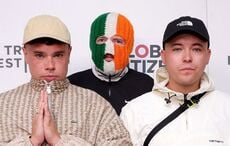A recent article examining the makeup ban for Irish dancers has reopened a debate which has divided generations of dancers and non-dancers alike.
For one Irish American family based in Boston the ban seems to have divided opinion in a house of champion dancers. Sisters Jacqueline and Abigail McGonigle, who were interviewed for the article, are both prominent Irish dancers but do not share the same attitudes on the controversial makeup ban.
Eight-year-old Jackie was relieved to hear that the Irish Dancing Commission’s new ruling, which went into effect March 1, prohibits her from wearing cosmetics in competitions.“I don’t like wearing the stuff. I think it looks bad,” she told the Boston Globe. The second grader, who has been dancing at Dunleavy-Shaffer School of Irish Dance in Norwell since she was 3. “The lipstick is the worst part.”
But Jackie’s older sister, Abigail, was disappointed. “I think it just makes me look more pretty. I think I look better and the judges can see me better,” said the 9-year-old, who competes for top prizes regionally.
Both opinions are what currently divide the dancing world. The makeup ban, which also includes false eyelashes and tinted moisturizer, prohibits children in the Under 10 group and younger from wearing it for solo and group competitions.
According to the Globe article, a spokeswoman for the Dublin-based organization that governs competitive Irish dancing worldwide, the IDC, said that they announced the ban “in an effort to bring the conversation back to the skill and not purely the aesthetic.”
“I suppose the public perception of Irish dancing had changed dramatically. It’s an incredible art form, and often the skill was not the talking point,” the spokeswoman said. “We felt it was important to strip it back.”
Makeup bans already existed for novice and beginner dancers, but the explosion of competitive Irish dancing in the last 20 years – “It’s being performed on much bigger stages with brighter lights,” said Lennon – prompted the organization to extend it to young children who were competing at high levels previously exempt from the ban.
The article engages with many different voices of the Irish dancing world. Some argue that the performance is everything while others like the whole theatrical look to a performance.
Attracta Quinn, who runs her dance school, Scoil Rince Naomh Attracta, in the Boston/Metrowest area, said makeup isn’t the problem. It’s the small group of overly enthusiastic parents who paint their kids’ faces with a heavy cosmetics brush.
“It’s because of the few people who go overboard,” said Quinn, who performed in “Lord of the Dance” before opening her school in 2008. “Some people take it too far, but it’s called a costume for a reason. The makeup just finishes off the costume.”
And what a contemporary outfit it’s become. Quinn, who also judges several feis (Gaelic for competitions, pronounced fesh), said glittery costumes, elaborate curled wigs, and sparkly tiaras are all part of today’s performance package. Leaving the makeup out of the equation leaves the ensemble out of balance.
This controversy has been covered extensively here on IrishCentral and as it continues here are some of the comments from our readers on what they think about the ban.
One 16-year-old defended the world of Irish dancing in a letter she penned to IrishCentral to the critics who criticize the world she loves so much. “I have been dancing for six years, and there is nothing else that I love more,” she said.
New York-based Niall O'Leary, a former world champion, teacher, and adjudicator recently told IrishCentral that "As an Irish dancing adjudicator, my job is to focus on the skills of the dancers on the day, not presentation. I don't think there should be a major emphasis put on the presentation of dancers, on the day the best dancer comes in first place."
"Parents spend a lot of money on wigs and costumes, and this makeup that kids are wearing isn't just a cheap brand, it's expensive so its hard to tell a parent to go wipe it off their children."
O'Leary also added that it "is very easy to get sidetracked by issues on dresses and wigs; it needs to focus on dancing and that's the plain and simple fact."
The Boston Globe article also features Julie Meringer, a mother of three champion dancers and a teacher at O’Shea-Chaplin who is torn about the makeup ban. Meringer believes the dress/wig/makeup combination makes competitions more democratic.
“You can have a child with great technicality, and put a wig and makeup on them and they will have all that,” she said. “You can have another child who’s not as savvy. You put them in the package and it equalizes them on stage.”
The Belmont mom thinks the ban is, in part, a response to step dancing’s increased intensity that rivals playing on a club soccer team or dancing at Boston Ballet school.
“‘This cult’ my husband likes to call it,” she said. “It’s not a 3-month-a-year or a 6-month-a-year sport. It’s year round. You have to be fit. You have to be cross trained.”
It appears that the jury is still out on whether the makeup ban is really all that is wrong within the Irish dancing world.




Comments